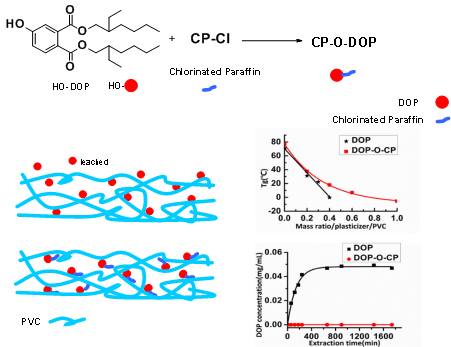
PVC是第二大合成材料,廣泛用于建筑材料、包裝材料、兒童玩具、家居用品、電線電纜,甚至用于血袋和尿袋、輸血管等許多醫療用材料等,幾乎涵蓋了我們生活的方方面面。由于PVC分子的強極性,分子間有很大的作用力,需要借助增塑劑才可以進行塑化加工。與其他聚合物材料不同,在PVC材料中增塑劑是不可或缺的添加劑或配合物。經過近一個世紀的發展,已開發不同種類的近千種增塑劑,不僅可以滿足不同塑化要求,而且決定最終制品的性能。甚至隨增塑劑的加入量不同,PVC制品可以從硬質制品到軟質制品隨意調節。PVC增塑劑中,使用量最大是鄰苯二甲酸酯類。其增塑效率高,適用范圍寬,得到廣泛應用。最具代表性的產品是鄰苯二甲酸二異辛酯(DOP),占到整個增塑劑用量的60~70%。
但是,增塑劑有個致命缺陷。增塑劑是小分子,極易從PVC材料中遷移出來。隨著增塑劑的流失,材料的性能也在逐步劣化而失去使用價值。所以,對增塑劑的要求中,除了溶劑化能力、相容性、高效率外,還要求保持性(Permanence)。為了阻止增塑劑遷移,開發出不少方法,如:制品表面交聯、制品表面涂層等,但這些方法非常繁瑣,只適用于一些特定應用。另外一個方法是聚合物增塑劑,增加增塑劑分子量,限制其遷移。然而,在限制增塑劑遷移的同時,也大大降低了增塑效率。
近20年來,增塑劑業面臨另外一個重大挑戰,增塑劑遷移而產生的污染問題引起重視,特別是增塑劑中用途最廣的,效率最高的鄰苯二甲酸酯類增塑劑因健康風險被多國限制使用。而替代產品的增塑效率遠趕不上鄰苯二甲酸酯類增塑劑。同時并沒有解決遷移問題,只是用其他增塑劑替代鄰苯二甲酸類增塑劑而已。這個問題看起來是鄰苯二甲酸酯類本身的問題,其實還可以歸結于增塑劑遷移問題。如果鄰苯二甲酸酯不遷移出制品,就不會對人體和環境產生影響。歐盟等并沒有限制遷移性較小分子量大的鄰苯二甲酸酯就是例證。沿著這個開發思路學術界也有研究,雖然解決了遷移問題,但是鄰苯二甲酸類增塑的高效率沒有發揮出來。就目前狀況而言,增塑劑開發似乎陷入一個怪圈,如果完全壓制遷移,就要犧牲增塑效率,如果注重增塑效率,要以遷移為代價。如何平衡遷移性與增塑效率,開發無遷移并同時具有高效增塑性的PVC增塑劑是一個重要挑戰。
針對這一難題,北京化工大學程斌教授課題組提出新的解決思路——調節增塑劑與PVC之間的相互作用力,平衡增塑劑遷移性與增塑性。如下圖所示,通過反應將DOP結構的分子與PVC相似結構的氯化石蠟結合成新的增塑劑。新的增塑劑增加了DOP與PVC的相互作用,限制了遷移,但是又不足以完全阻止增塑劑與PVC分子的“脫溶解”,所以仍能保持很高的增塑效率。

實驗結果表明,新的增塑劑/PVC 0.3/1(wt/wt)以下,增塑效率與DOP相當,高于0.3/1時,增塑效率較DOP下降,但是增加新增塑劑的量,仍能將PVC的玻璃化溫度降到0℃以下,能夠滿足絕大多數應用。溶劑抽提實驗評價增塑劑遷移性表明,同等條件下,抽提4個小時后,DOP全部損失。新增塑劑抽提30小時,沒有任何損失。顯示出極強的抗遷移性。
研究結果發表在Nature出版集團旗下的Scientific Reports上。
論文信息及鏈接:
Jun Yuan & Bin Cheng. A Strategy for Nonmigrating Highly Plasticized PVC. Scientific Reports, 2017, 7, Article number: 9277 (2017). doi:10.1038/s41598-017-10159-7
https://www.nature.com/articles/s41598-017-10159-7
參考文獻:
(1) Braun, D. Recycling of PVC. Prog. Polym. Sci.27(10), 2171-2195(2002).
(2) Rahman, M.,Brazel, C. S. The plasticizer market: an assessment of traditional plasticizers and research trends to meet new challenges. Prog. Polym. Sci. 29(12), 1223-1248(2004).
(3) Gayathri, N. S., Dhanya, C. R., Indu, A. R., Kurup, P. A. Changes in some hormones by low doses of di (2-ethyl hexyl) phthalate (DEHP), a commonly used plasticizer in PVC blood storage bags & medical tubing. Indian Journal of Medical Research. 119(4), 139-144(2004).
(4) Lee, K. Y. et al. Diverse developmental toxicity of di-n-butyl phthalate in both sexes of rat offspring after maternal exposure during the period from late gestation through lactation. Toxicology. 203(1), 221-238(2004).
(5) Thomas, J. A., Thomas, M. J., Gangolli, S. D. Biological effects of di-(2-ethylhexyl) phthalate and other phthalic acid esters. CRC critical reviews in toxicology.13(4), 283-317(1984).
(6) Janjua, N. R., Mortensen, G. K., Andersson, A. M., Kongshoj, B., Skakkebaek, N.E., Wulf, H. C. Systemic uptake of diethyl phthalate, dibutyl phthalate, and butyl paraben following whole-body topical application and reproductive and thyroid hormone levels in humans. Environmental science & technology. 41(15), 5564-5570(2007).
(7) Heudorf, U., Mersch-Sundermann, V., Angerer, J. Phthalates: toxicology and exposure. International journal of hygiene and environmental health. 210(5), 623-634(2007).
(8) Nagao, T. et al. Effect of butyl benzyl phthalate in Sprague-Dawley rats after gavage administration: a two-generation reproductive study. Reproductive Toxicology. 14(6), 513-532(2000).
(9) Lamb, J. C., Chapin, R. E., Teague, J., Lawton, A. D., Reel, J. R. Reproductive effects of four phthalic acid esters in the mouse. Toxicology and applied pharmacology. 88(2), 255-269(1987).
(10) Meeker, J. D, Sathyanarayana, S., Swan, S. H. Phthalates and other additives in plastics: human exposure and associated health outcomes. Philosophical Transactions of the Royal Society B: Biological Sciences., 364(1526), 2097-2113(2009).
(11) Rusyn, I, Corton, J. C. Mechanistic considerations for human relevance of cancer hazard of di (2-ethylhexyl) phthalate. Mutation Research/Reviews in Mutation Research. 750(2), 141-158(2012).
(12) Gupta, R. K. et al. Di-(2-ethylhexyl) phthalate and mono-(2-ethylhexyl) phthalate inhibit growth and reduce estradiol levels of antral follicles in vitro. Toxicology and applied pharmacology. 242(2), 224-230(2010).
(13) Reinsberg, J. et al. Effect of mono-(2-ethylhexyl) phthalate on steroid production of human granulosa cells. Toxicology and applied pharmacology. 239(1), 116-123(2009).
(14) Kluwe, W. M. et al. The carcinogenicity of dietary di (2‐ethylhexyl) phthalate (DEHP) in Fischer 344 rats and B6C3F1 mice. Journal of Toxicology and Environmental Health, Part A Current Issues. 10(4-5), 797-815(1982).
(15) Melnick, R. L. Is peroxisome proliferation an obligatory precursor step in the carcinogenicity of di (2-ethylhexyl) phthalate (DEHP). Environmental Health Perspectives. 109(5), 437(2001).
(16) Chipman, J. K., Mally, A., Edwards, G. O. Disruption of gap junctions in toxicity and carcinogenicity. Toxicological Sciences. 71(2), 146-153(2003).
(17) Choi, J., Kwak, S. Y. Hyperbranched poly (ε-caprolactone) as a nonmigrating alternative plasticizer for phthalates in flexible PVC. Environmental science & technology. 41(10), 3763-3768(2007).
(18)Adelia Ferreira Faria-Machado, Mariana Altenhofen da Silva, Melissa Gurgel Adeodato Vieira, Marisa Masumi Beppu. Epoxidation of Modified Natural Plasticizer Obtained from Rice Fatty Acids and Application on Polyvinylchloride Films. J. Appl. Polym. Sci. 127(5), 3543-3549(2013).
(19) Chen, J., Li, X., Wang,Y., Huang, J., Li, K., Nie, X. and Jiang1, J. Synthesis and application of environmental soybean oil-based epoxidized glycidyl ester plasticizer for poly(vinyl chloride). Eur. J. Lipid Sci. Technol. 119(5), DOI: 10.1002/ejlt.201600216(2017).
(20) Melissa Gurgel Adeodato Vieira, Mariana Altenhofen da SilvaI, André Costa Gomes Ma?umotoI, Lucielen Oliveira dos Santos, Marisa Masumi Beppu. Synthesis and application of natural polymeric plasticizer obtained through polyesterification of rice fatty acid. Materials Research. 17(2), 386-391(2014).
(21) Chiellini, F., Ferri, M., Morelli, A., Dipaola, L., Latini, G. Perspectives on alternatives to phthalate plasticized poly (vinyl chloride) in medical devices applications. Prog. Polym. Sci.38(7), 1067-1088(2013).
(22) Fernandez, S., Kunchandy, S., Ghosh, S. Linseed oilplasticizer based natural rubber/expandable graphite vulcanizates: Synthesis and characterizations. J. Polym. Environ. 23, 1–8(2015).
(23) Chavan, P., Gogate, R. Ultrasound assisted synthesis ofepoxidized sun?ower oil and application as plasticizer. J. Ind.Eng. Chem. 21, 842–850(2014).
(24) Choi, W., Chung, J. W., Kwak, S.Y. Unentangled Star-Shape Poly(ε-caprolactone)s as Phthalate-Free PVC Plasticizers Designed for Non-Toxicity and Improved Migration Resistance. ACS Appl. Mater. Interfaces. 6 (14), 11118–11128(2014).
(25) Erythropel, H.C., Shipley, S., B?rmann, A., Nicell, J.A., Maric, M. and Leask, R.L. Designing green plasticizers: Influence of molecule geometry and alkyl chain length on the plasticizing effectiveness of diester plasticizers in PVC blends. Polymer. 89, 18-27(2016).
(26) Erythropel, H.C., Dodd, P., Leask, R.L., Maric, M. and Cooper, D.G. Designing green plasticizers: influence of alkyl chain length on biodegradation and plasticization properties of succinate based plasticizers. Chemosphere. 91(3), 358-365 (2013).
(27) Kastner, J., Cooper, D.G., Mari?, M., Dodd, P. and Yargeau, V. Aqueous leaching of di-2-ethylhexyl phthalate and “green” plasticizers from poly (vinyl chloride). Science of the Total Environment. 432, 357-364(2012).
(28) Mercedes Cerezuela Barreto, Jochen Borris, Michael Thomas,Renate H?nsel, Michael Stoll, Claus-Peter Klages. Reduction of Plasticizer Leaching from PVC by Barrier Coatings Deposited Using DBD Processes at Atmospheric Pressure. Plasma Process. Polym. 9, 1208–1214(2012).
(29) Levin, G. Stabilized PVC products and their production. U.S. Patent 5,209,931, May 11, 1993.
(30) Levin G. Prevention of plasticizer migration from PVC products. U.S. Patent 4,806,393, Feb. 21, 1989.
(31 ) Messori, M. et al. Prevention of plasticizer leaching from PVC medical devices by using organic–inorganic hybrid coatings. Polymer. 45(3), 805-813(2004).
(32) Braslau R., Schaffner F., Earla A. Polymeric Phthalates: Potential Nonmigratory Macromolecular Plasticizers. Journal of Polymer Science. Polymer Chemistry. 51, 1175–1184(2013).
(33) Gooch, J.W. Polymeric Plasticizer 564 (Springer New York , 2011).
(34) Tarvainen, M., Sutinen, R., Somppi, M., Paronen, P., Poso, A. Predicting Plasticization Efficiency from Three-Dimensional Molecular Structure of a Polymer Plasticizer. Pharmaceutical Research. 18(12), 1760–1766(2001).
(35) Navarro, R., Pérez, P. M., Gómez Tardajos, M. and Reineckeet, H. Phthalate plasticizers covalently bound to PVC: plasticization with suppressed migration. Macromolecules. 43(5), 2377-2381(2010).
(36) Daniels, P. H. A Brief Overview of Theories of PVC Plasticization and Methods Used to Evaluate PVC-Plasticizer Interaction. J. Vinyl Addit. Technol. 15, 219–223(2009).
(37) Edmumd, H., Immergut and Herman F. MARK. Principles of Plasticization Plasticization and Plasticizer Processes., 1-26(1965).
- 青海大學劉秉鑫、高莉課題組 CEJ:通過加入環保型MgLaCe水滑石(LDH)揭示PVC薄膜的綜合性能和安全性進步 2024-09-04
- 南工大材料學院 JCLP:基于一鍋法“升級改造”(upcycle)策略制備雙連續相導熱功能材料 2023-12-15
- 北方民族大學郭生偉團隊《J. Mater. Res. Technol.》:用于新型PVC建材的粉煤灰大宗高值利用 2023-02-26
- 南工大材料學院 IJBM :通過加入ADR擴鏈劑和生物資源增塑劑-增強聚(乳酸)和聚(對苯二甲酸-己二酸丁二醇酯)共混物的韌性 2025-01-03
- 北化馮岸超副教授和澳大利亞學者合作《Macromolecules》:在RAFT聚合制備星形聚氯乙烯增塑劑領域取得新進展 2021-06-03
- 天大陳宇教授&美國橡樹嶺國家實驗室曹鵬飛研究員團隊:一種賦予聚氯乙烯基塑料高度可伸縮性、超韌性以及多功能性的綠色大分子添加劑 2021-04-08
